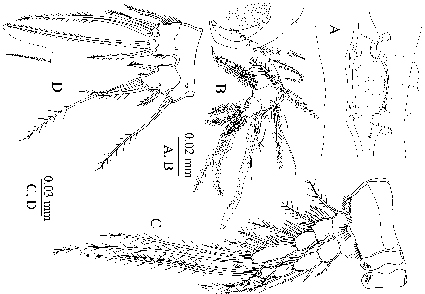Abstract
The previously unknown females of Danielssenia spitsbergensis Gee & Huys, 1994 and males of Mucrosenia kendalli Gee & Huys, 1994 (Pseudotachidiidae, Danielsseniinae) are described based on specimens collected in the Kara and East Siberian Seas.
Females of D. spitsbergensis exhibit the main diagnostic features of the genus Danielssenia Boeck, 1873 (antennule four-segmented; proximal segment of antennary exopod with one seta; structure of all the mouthparts; absence of an inner seta on exopod-1 of P2–P4; P5 not fused medially and with distinct exopod and baseoendopod, the latter with five setae; genital field with small copulatory pore and short copulatory duct leading to seminal receptacle with paired anterior chambers). At the same time, these specimens also exhibit some distinctive features which are unique for the species but disagree with the generic diagnosis. These peculiarities validate the placing of D. spitsbergensis as species incertae sedis within Danielssenia and point out the necessity of examination of other ‘Danielssenia-like’ forms before the true taxonomic position of this species can be elucidated.
Both males and females of M. kendalli exhibit the autapomorphies of the genus, viz. P2 endopod-2 with a mucroniform process reaching almost to end of endopod-3 (this sexually dimorphic character is more pronounced in the males but also present in females); P2 endopod-2 without inner seta; posterior displacement of caudal ramus seta II; presence of tuft of long setules at inner distal corner of caudal ramus; P2 endopod shorter than exopod; P2–P4 exopod-1 without inner seta. Furthermore, some particular features (anal somite and pseudoperculum morphology; female P1 endopod distinctly longer than exopod; P5 exopod with distinct suture on dorsal surface separating it from the baseoendopod; prominent mucroniform process on P2 endopod-2) of the Kara and East Siberian Sea specimens conform fully with the original description of M. kendalli but apparently differ from M. kliei (Smirnov, 1946), the single female of which was collected from the same region and depth. Therefore, the validity and definite status of the specimen described by Smirnov is still a matter of conjecture pending additional findings and, particularly, the discovery of the male.
References
Boeck, A. (1873) Nye Slægter og Arter af Saltvands-Copepoder. Forhandlinger i Videnskabsselskabet i Kristiania, 1872, 35–60.
Chertoprud, E., Abramova, E., Korsun, S., Martynov, F. & Garlitska, L. (2018) Composition of Harpacticoida (Crustacea, Copepoda) of the Laptev Sea in comparison with faunas of adjacent Arctic seas. Polar Biology, 41, 697–712. https://doi.org/10.1007/s00300-017-2229-6
Garlitska, L.A. & Azovsky, A.I. (2016) Benthic harpacticoid copepods of the Yenisei Gulf and the adjacent shallow waters of the Kara Sea. Journal of natural History, 50, 2941–2959. https://doi.org/10.1080/00222933.2016.1219410
Garlitska, L.A., Chertoprud, E.S., Portnova, D.V. & Azovsky A.I. (2019) Benthic Harpacticoida of the Kara Sea: species composition and bathymetrically related distribution. Oceanology, 59, 541–551. https://doi.org/10.1134/S0001437019040064
Gee, J.M. & Huys, R. (1994) Paranannopidae (Copepoda: Harpacticoida) from sublittoral soft sediments in Spitzbergen. Journal of natural History, 28, 1007–1046. https://doi.org/10.1080/00222939400770541
Huys, R. & Boxshall, G.A. (1991) Copepod Evolution. The Ray Society, London, 468 pp.
Huys, R. & Gee, J.M. (1993) A revision of Danielssenia Boeck and Psammis Sars with the establishment of two new genera Archisenia and Bathypsammis (Harpacticoida: Paranannopidae). Bulletin of the Natural History Museum, London, Zoology, 59, 45–81.
Huys, R., Gee, J.M., Moore, C.G. & Hamond, R. (1996) Marine and Brackish Water Harpacticoids, Part 1. In: Barnes, R.S.K. & Crothers, J.H. (Eds.), Synopses of the British Fauna, New Series, 51, 1–352.
Lang, K. (1936) Copepoda Harpacticoida. Further zoological Results of the Swedish Antarctic Expedition 1901–1903 under the Direction of Dr Otto Nordenskjöld, 3 (3), 1–68.
McIntyre, A.D. & Warwick, R.M. (1984) Meiofauna techniques. In: Holme, N.A. & McIntyre, A.D. (Eds.) Methods for the study of marine benthos. Blackwell, Oxford, pp. 217–244.
Sars, G.O. (1903) Copepoda Harpacticoida. Parts I & II, Misophriidæ, Longipediidæ, Cerviniidæ, Ectinosomidæ (part). An account of the Crustacea of Norway, with short Descriptions and Figures of all the Species, 5, 1–28, pls. I–XVI.
Smirnov, S.S. (1946) New species of Copepoda-Harpacticoida of the northern Arctic Ocean. In: Buynitskiy V. Kh. (Ed.), Trudy Dreifuyuschei Ekspeditsii Glavsevmorputi na Ledokol’nom Parokhode “G. Sedov” 1937–1940 yrs. Vol 3. Glavsevmorput, Moscow-Leningrad, pp. 231–263. [in Russian with English and German summaries]
Soyer, J. (1970) Contribution à l’étude des Copépodes Harpacticoïdes de Méditerranée occidentale. 2. Tachidiidae Sars, Lang. Vie et Milieu, (A), 21, 261–278.
Wells, J.B.J. (2007) An annotated checklist and keys to the species of Copepoda Harpacticoida (Crustacea). Zootaxa, 1568 (1), 1–872. https://doi.org/10.11646/zootaxa.1568.1.1


